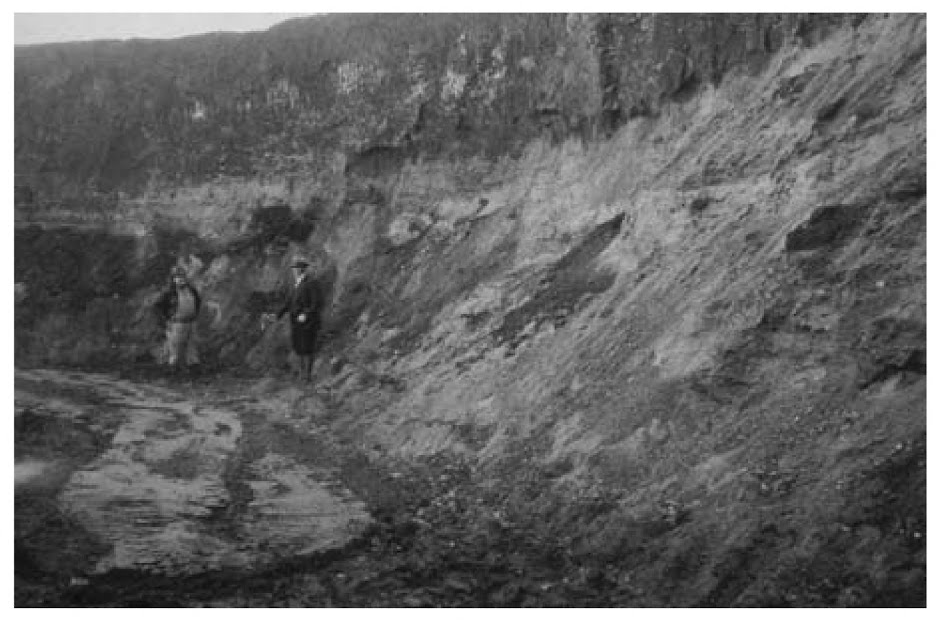This is a guest post by Chas Stewart. For more of his work, check out the podcast Blue Ball Skeptics and his Twitter feed.
A couple of my friends know that I love archaeology, so they pointed me to this article out of the ballyhooed NewsOK op-ed section, titled very impressively:
OU Professor: Prehistoric Man in Oklahoma
Yes, copy editor, David Deming is an OU professor. But he’s also a climate denier so looks and titles can be deceiving. In this op-ed, Deming is contending that we should radically change the timeline for human occupation of the Americas based on the Holloman Gravel Pit site that was dug in the 1920s.
The Holloman Gravel Pit site was a remarkable case study. A.H. Holloman, an old Okie quarry proprietor, found metates, manos, stone points, and “bones of mammoth, mastodon, sloth, horse, and camel” in his gravel pit. Subsequently, word got out about these amazing finds, attracting Harold Cook and J.D. Figgins of the Colorado Museum of Natural History to Frederick, OK where Holloman showed them artifacts and walked them around the pit to show where they were found.
Cooks and Figgins were amazed at the site’s findings, mostly because they did some back of the envelope calculations and decided the artifacts were roughly 365,000 years old. This would have pushed back the arrival of humans in the Americas by hundreds of thousands of years! But, they decided that they needed validation of this, so they hired O.F. Evans to analyze the soil. Sadly, Evans thought that the pit was no older than 10,000 years old and could be much younger. Evans even published a detailed description of the probable history for this pit in the 1930 issue of the journal Proceedings of the Oklahoma Academy of Science.
Cook didn’t agree and neither does Deming, today, but look at this picture of the quarry in 1927 below. While this is a regular way to cut earth and displace gravel, it is certainly not a normal way to conduct an archaeological dig.
In typical archaeological digs (even in the 1930s), you dig in such a way so that you can trace the soil changes and have a much greater chance of finding artifacts in situ, which will help when you start making crazy assertions about what you found under the ground. Holloman was the only one to find all of the artifacts, with the scholars were relying on this amateur to accurately relay precisely where the artifacts were found. But, even if the guy was completely honest and accurate, how were the artifacts found? With a trowel?
Honestly, the Holloman Gravel Pit is a very cool site and I remember learning about it from Don Wyckoff. But it is also an example of a site with many amazing artifacts and fossils that teaches us…nothing much, sadly, because it was impossible to establish provenance for the articles. To see an example of great excavation work, check out the Berry Site outside of Morganton, North Carolina. It’s a peek in to the first contact between the native population and the Conquistadors, and every year they hold a field day to show it off to the locals. Without fail, every year people bring their bins of arrowheads and whatnots and ask what the experts think. Unfortunately, the reply is usually just “Looks cool.” There’s not much more to say because the item doesn’t tell you much until its provenance is known.
Deming, though, is not phased by this “scientific dogmatism” that has been blunting the “truth” uncovered at the Holloman site. Apparently he’s been beating this drum since the late 1990s, even writing for the pseudoscientific publication The Pleistocene Coalition (which promotes the scientifically-invalid idea that humans were in the Americas some 250,000 or more years ago). But, maybe now you understand why Deming is way out there on the ledge by himself.
For a serious breakdown of the Holloman Gravel Pit, you can read David J. Meltzer’s book Folsom: New Archaeological Investigations of a Classic Paleoindian Bison Kill, and check out the Google Books preview here.

